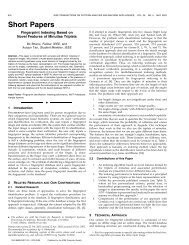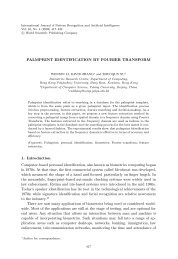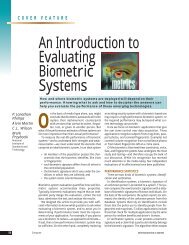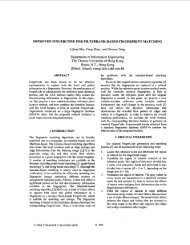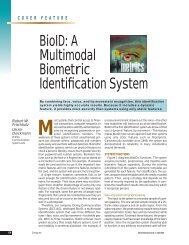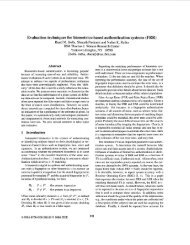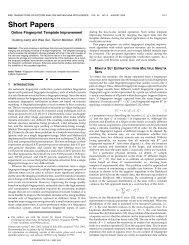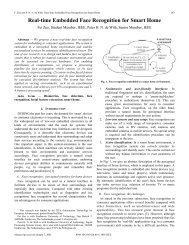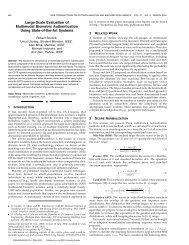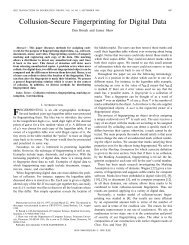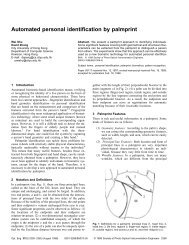A Multichannel Approach to Fingerprint Classification
A Multichannel Approach to Fingerprint Classification
A Multichannel Approach to Fingerprint Classification
You also want an ePaper? Increase the reach of your titles
YUMPU automatically turns print PDFs into web optimized ePapers that Google loves.
JAIN ET AL.: A MULTICHANNEL APPROACH TO FINGERPRINT CLASSIFICATION 3553 CLASSIFICATIONAu<strong>to</strong>matic classification of fingerprints is a difficult problembecause of the small interclass variability and large intraclassvariability among the five classes under consideration.In order <strong>to</strong> simplify the classification task, we decomposethe five-class problem in<strong>to</strong> a set of 10 two-class problems.Further, we use a two-stage classifier for fingerprintclassification. In the first stage, we use a K-nearest neighborclassifier <strong>to</strong> find the two most probable classes for a giveninput pattern. The K-nearest neighbor decision rule firstfinds the K nearest neighbors of the test pattern in the featurespace and, then, assigns the test pattern <strong>to</strong> the classwhich is most frequently represented among the K nearestneighbors. The <strong>to</strong>p two categories can be retrieved from theK-NN classifier corresponding <strong>to</strong> the classes which have thehighest and the second highest count among the K nearestneighbors, i.e., the first recall and the second recall. In thesecond stage of the classifier, a set of 10 (C 2 5 ) neural networksare trained <strong>to</strong> solve the 10 different two-class problems.The second stage uses the first and second recalls <strong>to</strong>select the specific neural network which has been trained <strong>to</strong>distinguish between the corresponding pair of classes andthe input pattern is then sent <strong>to</strong> the selected neural networkfor further classification. This neural network makes thefinal decision between these two classes.4 EXPERIMENTAL RESULTS4.1 DatasetWe report the results of our fingerprint classification algorithmon the NIST-4 database for the five-class fingerprintclassification problem. Since fingerprint classes A (arch) andT (tented arch) have a substantial overlap, it is very difficult<strong>to</strong> separate these two classes. Therefore, we also report ourresults for the four-class classification problem, whereclasses A and T have been merged in<strong>to</strong> one class. By incorporatinga rejection option, classification accuracy can beincreased. We report the improvement in error rates at differentrejection rates for both the five-class and the fourclassclassification problems.The NIST-4 database consists of 4,000 fingerprint images(image size is 512 480) from 2,000 fingers. Each finger hastwo impressions (f and s). Each image is labeled with one ormore of the five classes (W, R, L, A, and T). To simplify thetraining procedure, we make use of only the first label of afingerprint <strong>to</strong> train our system. For testing, however, wemake use of all the labels for a fingerprint and consider theoutput of our classifier <strong>to</strong> be correct if the output matchesany one of the labels. This is in line with the common practiceused by other researchers in comparing the classificationresults on the NIST-4 database. The images in theNIST-4 database are numbered f0001 through f2000 ands0001 through s2000. Each number represents a fingerprintfrom a different finger. We form our training set with thefirst 2,000 fingerprints from 1,000 fingers (f0001 <strong>to</strong> f1000 ands0001 <strong>to</strong> s1000) and the test set contains the remaining 2,000fingerprints (f1001 <strong>to</strong> f2000 and s1001 <strong>to</strong> s2000). The naturalproportion of fingerprints belonging <strong>to</strong> each class is 0.279,0.317, 0.338, 0.037, and 0.029 for the classes W, R, L, A, andT, respectively [6]. <strong>Classification</strong> accuracies can be significantlyincreased by using datasets whose records follow thenatural distribution of fingerprint classes because the morecommon types of fingerprints (loop and whorl) are easier <strong>to</strong>recognize. However, we do not use datasets with a naturalclass distribution. Twenty-eight fingerprints from thetraining set were rejected by our feature extraction algorithmbecause the center was detected at a corner of theimage and, therefore, a valid tessellation could not be establishedfor these images (Fig. 10). Thirty-five fingerprintswere rejected from the test set for the same reason. So, ourtraining set contains 1,972 fingerprint images. The 35 imagesrejected from the test set of 2,000 fingerprints amounts<strong>to</strong> a reject rate of 1.8 percent.4.2 K-Nearest Neighbor ClassifierThe K-nearest neighbor classifier results in an accuracy of85.4 percent for the five-class classification task when 10nearest neighbors (K = 10) are considered. <strong>Classification</strong>accuracy does not always increase with increasing K; thereexists an optimal value of K for finite training sample sizeclassification problems (Fig. 11) [19]. For the four-class classificationtask (where classes A and T were collapsed in<strong>to</strong>one class), an accuracy of 91.5 percent is achieved. The confusionmatrix for the K-nearest neighbor classification isshown in Table 1. The diagonal entries in this matrix showthe number of test patterns from different classes which arecorrectly classified. Since a number of fingerprints in theFig. 10. Example of images which were rejected because a valid tessellationcould not be established.Fig. 11. K vs. percent error for the K-nearest neighbor classifier.



